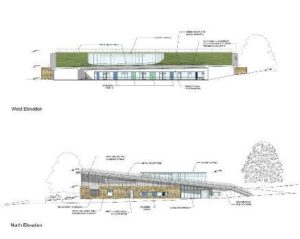Case Study 29 – Small Animal Hospital
John Graham (Dromore)
Ecomesh, Ulster
Stone features
The outer structure of the building is made up of gabions. These are modular building blocks that are formed from wire mesh baskets, densely filled with carefully placed pieces of stone. The gabions are fixed by an extended foundation toe to support the baskets. The stone used in this case was brown quartzite (a hard metamorphic stone) from Ulster, which is where the gabions baskets were manufactured. These were then shipped over as flat pack modular elements and assembled on site. The stone was hand placed into the baskets to create a horizontal coursing, which sits well against the verticality of the flat-wire mesh baskets.
Special techniques
The gabion wall acts as a stone rainscreen, which is naturally vented and free draining. The stone construction enhances the aesthetic quality of the building, as the selected material complements the relationship that the building has with the surrounding landscape. Compared with constructing a traditional stone wall, gabion construction is much quicker and less expensive.

Background to building
Located at the entrance to the grounds of the Garscube Estate, the new Small Animal Hospital, (part of Glasgow University Faculty of Veterinary Medicine), provides state of the art services for animal owners and referring practitioners. Although the structure is large, its form is cut into the landscape, the roof creating an angled grassy hillside, thus marrying the building into its landscape setting. This design solution has successfully used the site topography to slide the building under the grassy hill, expressing itself to the public through a projecting glass ‘crystal’.
Internally, the building is simply organised, both horizontally and vertically with clear division of public and private hospital spaces. The building is in three layers, the working hospital is located between the external gabion wall, and the middle layer which houses the hospital proper. This in turn wraps around the central treatment hub, which acts as the heart of the building. The treatment rooms and office space occupy the upper level with views of the estate and providing access to the grass roof.










